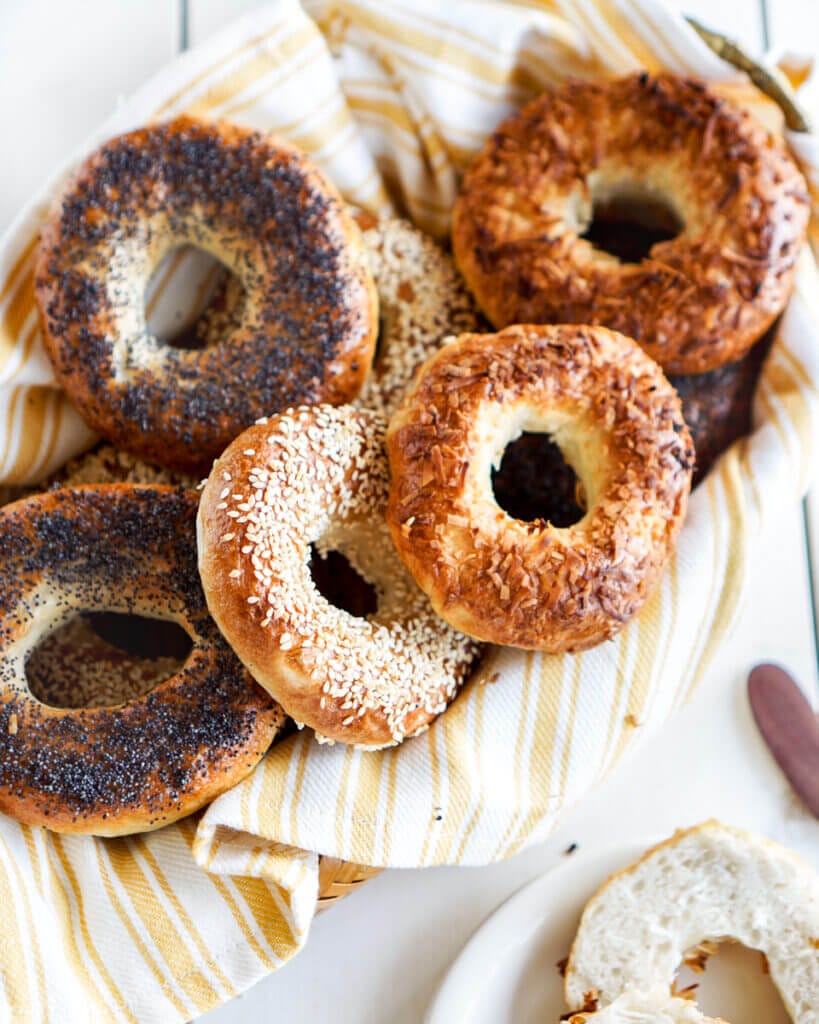
Have you ever made homemade bagels? You won’t believe how enjoyable it is to make them yourself! It may not be a weekly baking routine but it’s definitely a fun baking activity to try out. You can play around with different toppings and seeds to make your own bagel variety pack too!
When it comes to working with yeast, it can be a bit intimidating. I’ve got a few helpful tips on working with yeast, proofing, and the most problematic – over-proofing, aka why did my dough flop? I hope this helps in making you more confident when it comes to working with yeast and making your own homemade bagels.
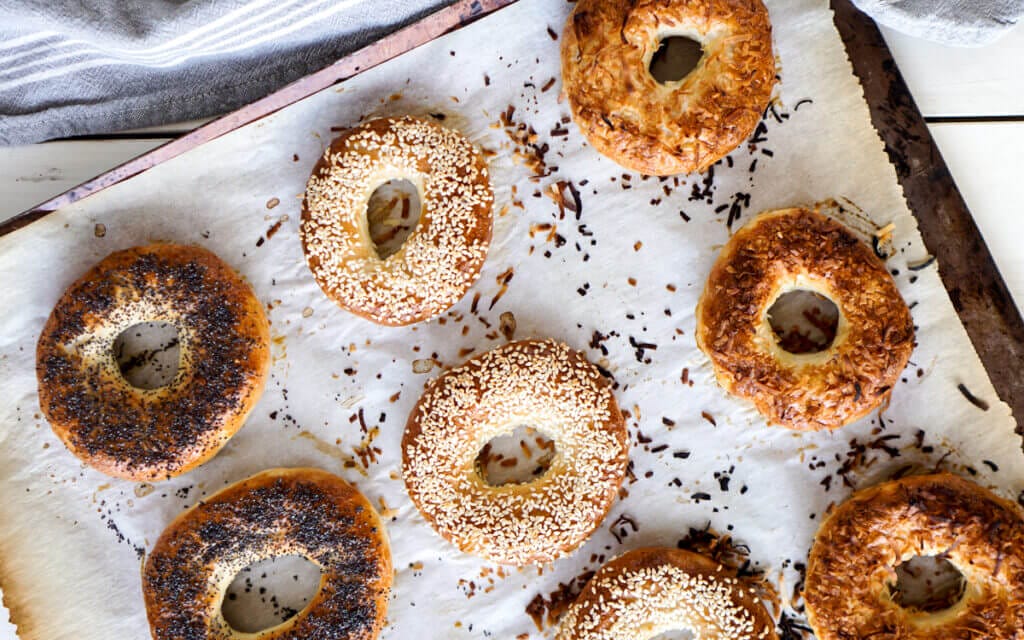
Ingredients
- All-purpose flour
- Water
- Active dry yeast
- Granulated sugar
- Egg wash
- Salt
- Seeds for topping (optional)
Homemade Bagel Variations
- Everything – poppy seeds, sesame seeds, dried minced garlic, dried minced onion, flaked sea salt or coarse salt
- Poppy Seed
- Sesame Seed
- Onion – dried minced onion
- Rosemary and sea salt
- Cheese – add 1/3 cup of mixed cheeses, sharp cheese pairs the nicest. Top with extra cheese before baking.
- Blueberry – add 1/2 cup fresh blueberries to the dough.
- Chocolate chip – add 1/2 cup mini chocolate chips to the dough.
- Cinnamon & raisin – add 1/4 cup raisins and 1/2 teaspoon cinnamon to the dough.
- Jalapeño and cheese – add 1 thinly sliced and seeded jalapeño pepper plus 1/3 cup white cheddar cheese to the dough. Top with extra cheese before baking.
- Coconut – add 1/2 cup shredded coconut to the dough. Top with extra coconut before baking.
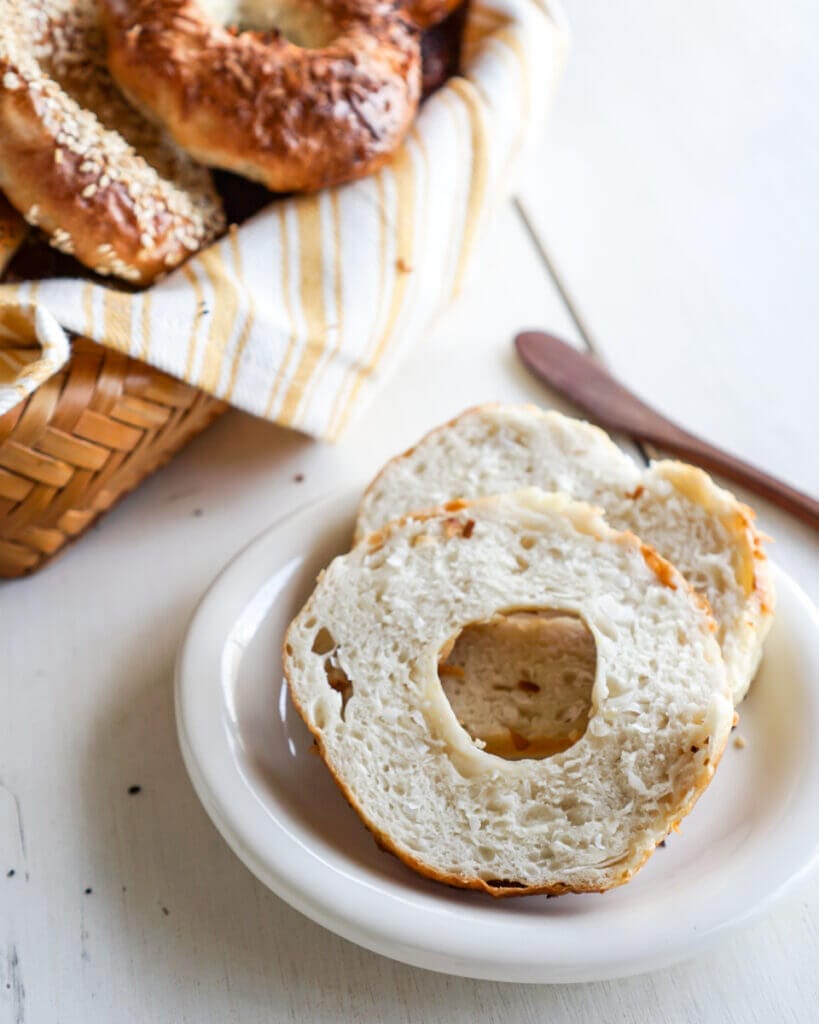
Tips For Making Bagels
What to look for when proofing yeast
When using active dry yeast you need to break down the coating to activate the yeast. After your yeast has sat (proofing) in warm water for approx. 5-10 minutes you should have a foamy mixture, sometimes with bubbles. This will all depend on how active your yeast is. If you look closely you should see your yeast moving in the water. This is a great sign your yeast is active. Sometimes recipes call for a little sugar, this can help activate the yeast as it eats the sugar to activate. If your yeast is not foamy or you see no activity your yeast is most likely dead and this will cause your bread to not rise. Check your expiry date before using and store in the fridge (or if you don’t use your yeast often you can store in the freezer).
How do you know when your dough is ready?
You want your dough to be smooth and elastic looking after kneading. If you are using a mixer with a dough hook, take your dough out and knead it a few times so you can see how smooth and elastic it is. Shape your dough into a ball and gently press your finger into the dough. If the dough springs back it’s ready to proof. If the dough doesn’t spring back you have to knead it a bit longer.
What is Overproofing?
It is very important to keep an eye on your dough and its activity. If you overproof your dough, your dough will have no structure to hold itself together and will flop. All the air bubbles and gases pop and leave the dough, resulting in overproofing. You can tell by how much the dough has grown and if you press your finger into the dough and it doesn’t spring back it means it’s overproofed. If this happens, you can save the first proof by pressing the gases out, reshaping the dough, and reproofing.
When a recipe calls for more yeast, your proofing time should be shorter. Proofing time all depends on how warm it is where your dough is resting, how active your yeast is, and how much yeast is used in the recipe.
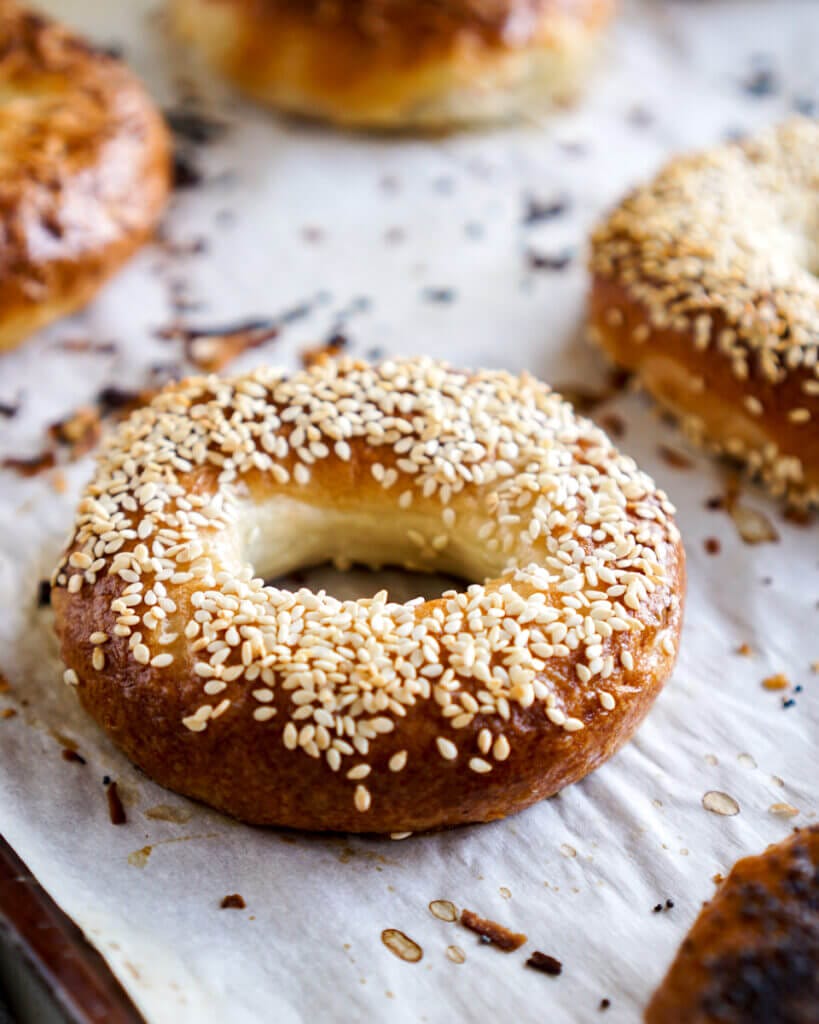
How To Make Homemade Bagels
Step One: Make your dough and let rest until doubled in size. Then divide the dough into 12 equal pieces. Shape dough into round balls, and flatten into discs. Use the handle of a wood spoon to poke a hole in the centre of the dough. Slip the dough halfway down the wooden handle and then gentle spin it around to create a large opening (you can do this with your fingers/hand as well). Repeat with the other pieces.
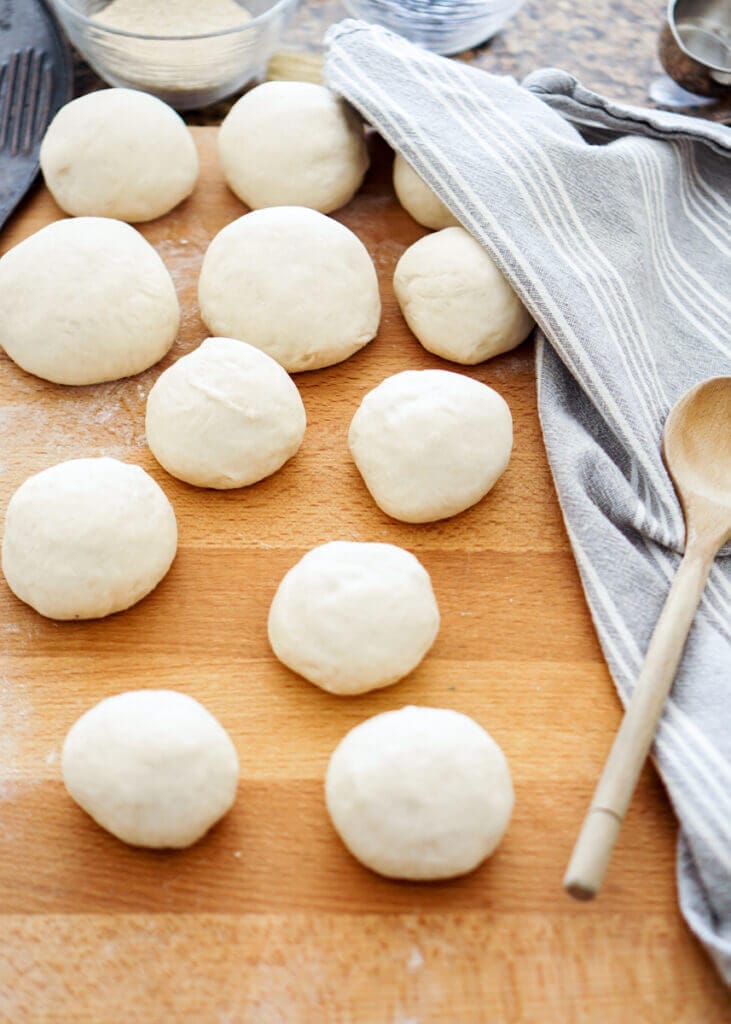

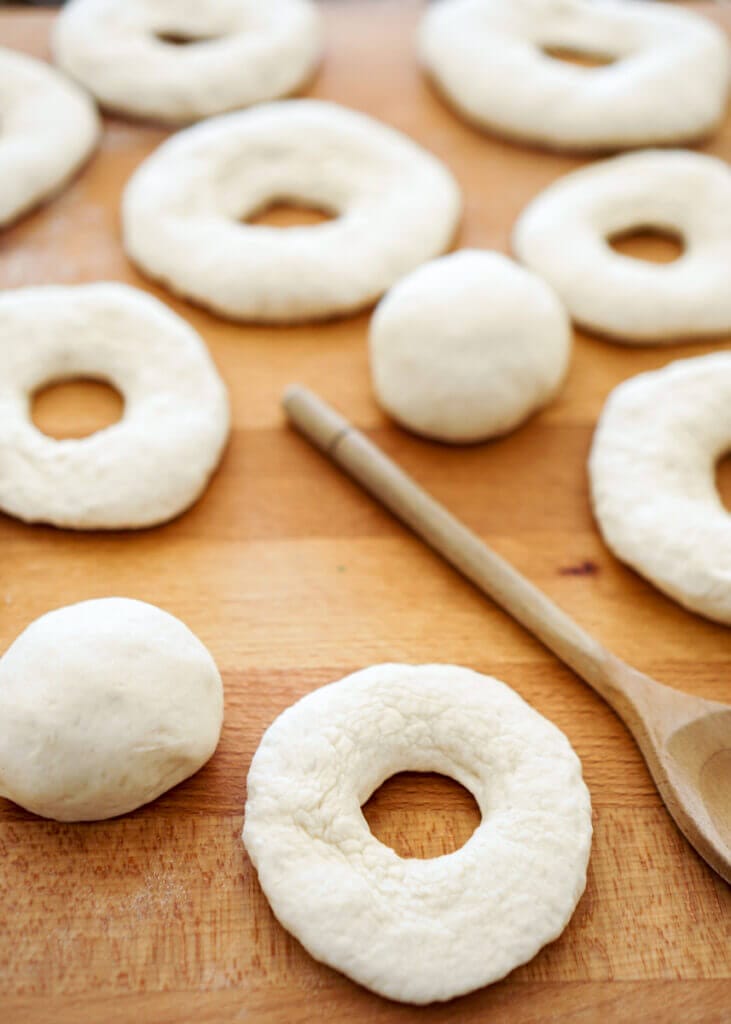
Step Two: Place up to two bagels in a pot of boiling, boil for 1 minute on each side. Using a slotted spoon remove bagels onto a baking sheet.
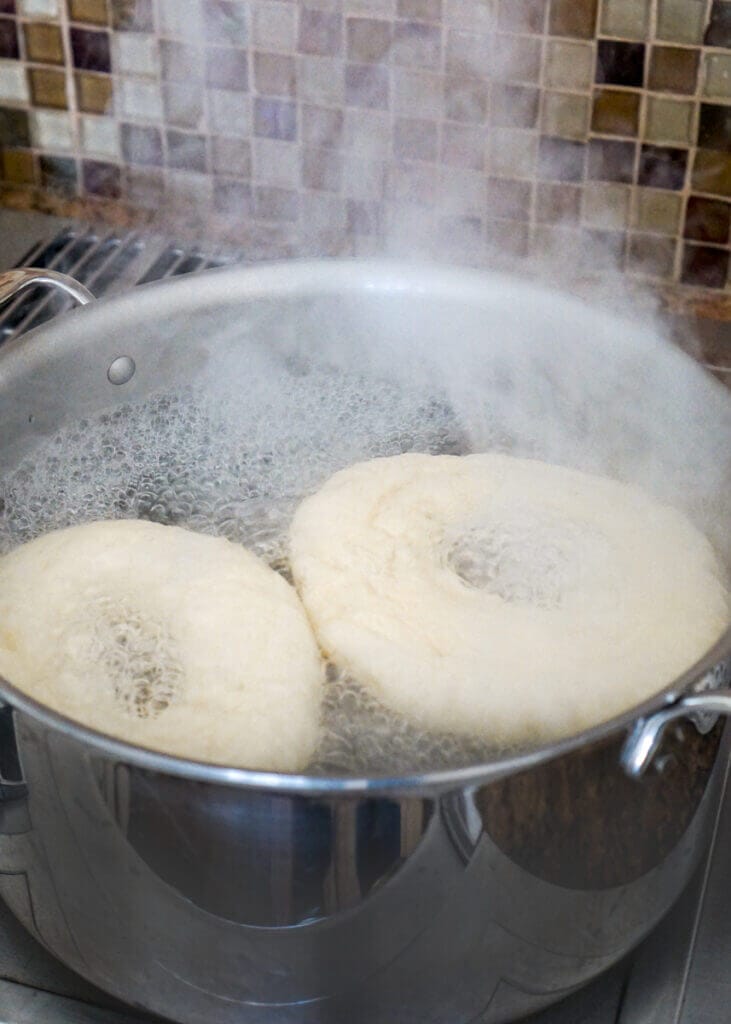
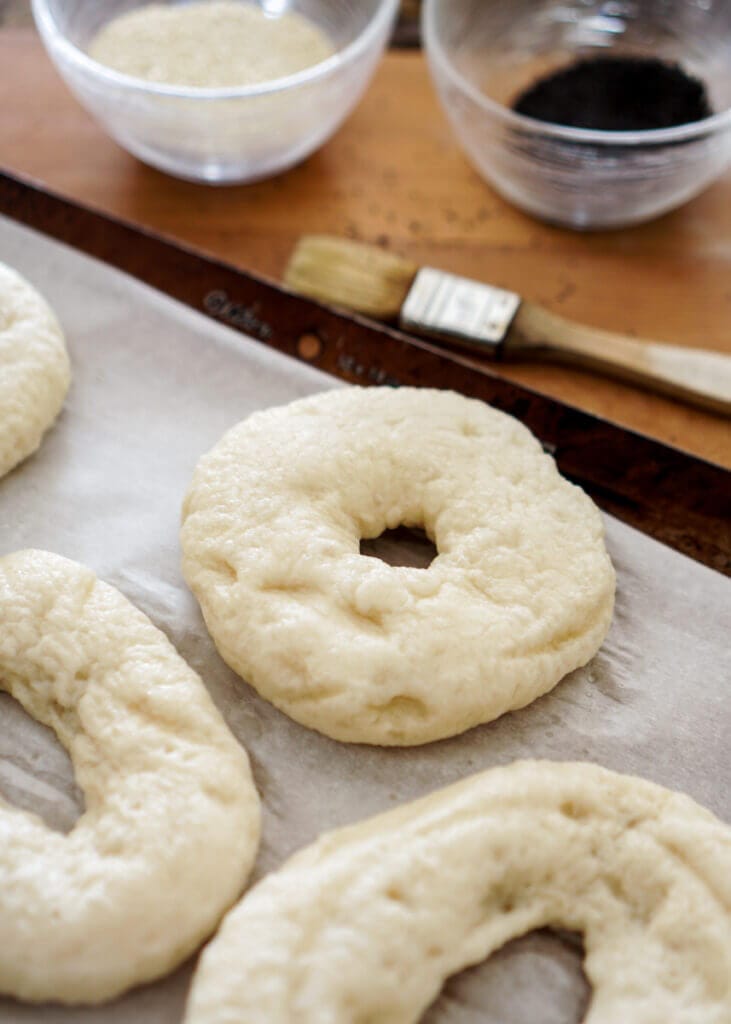
Step Three: Brush the bagels with egg wash and sprinkle desired seeds on top. Bake in the middle of the oven for approximately 20 minutes or until the bottoms are browned and when tapped the bagel sounds hollow.
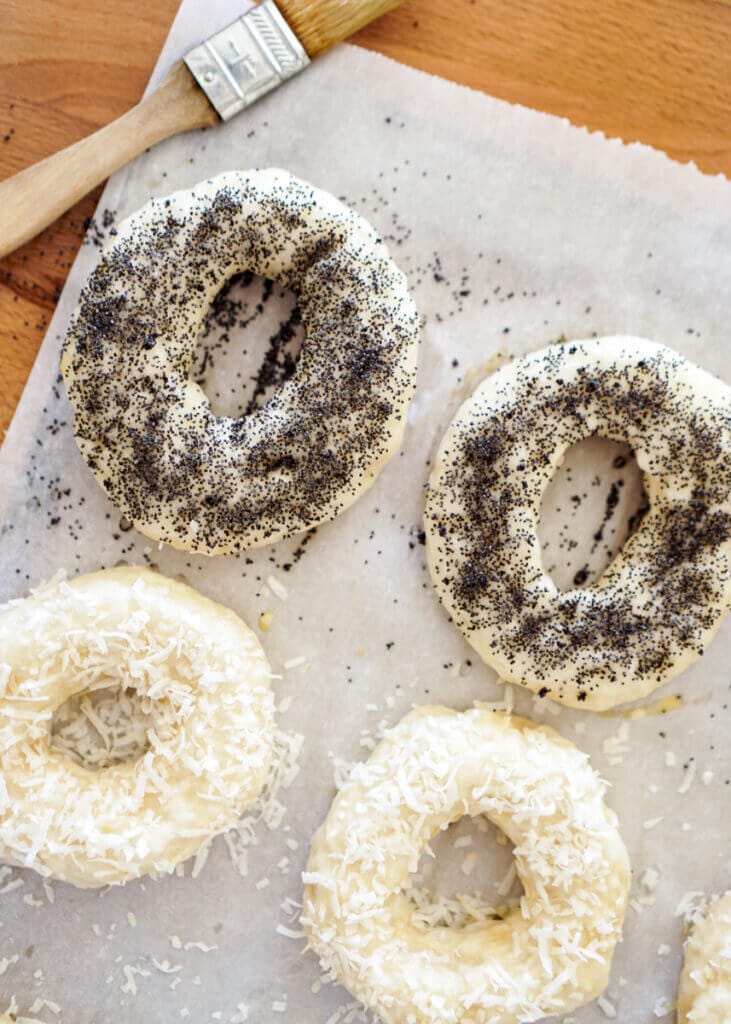
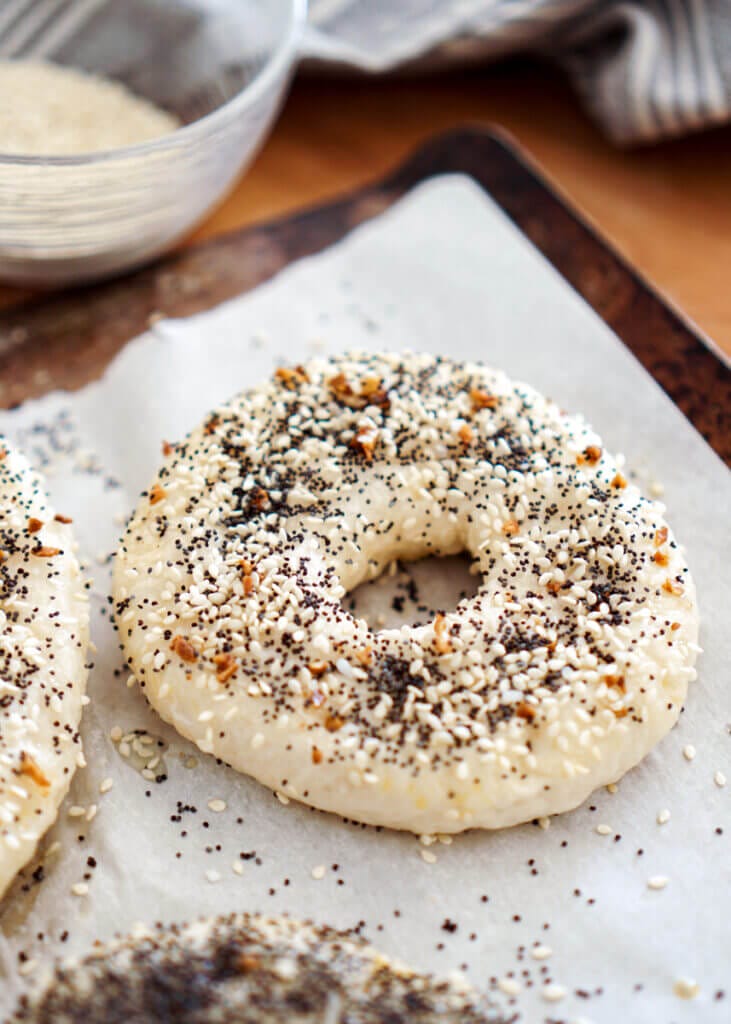
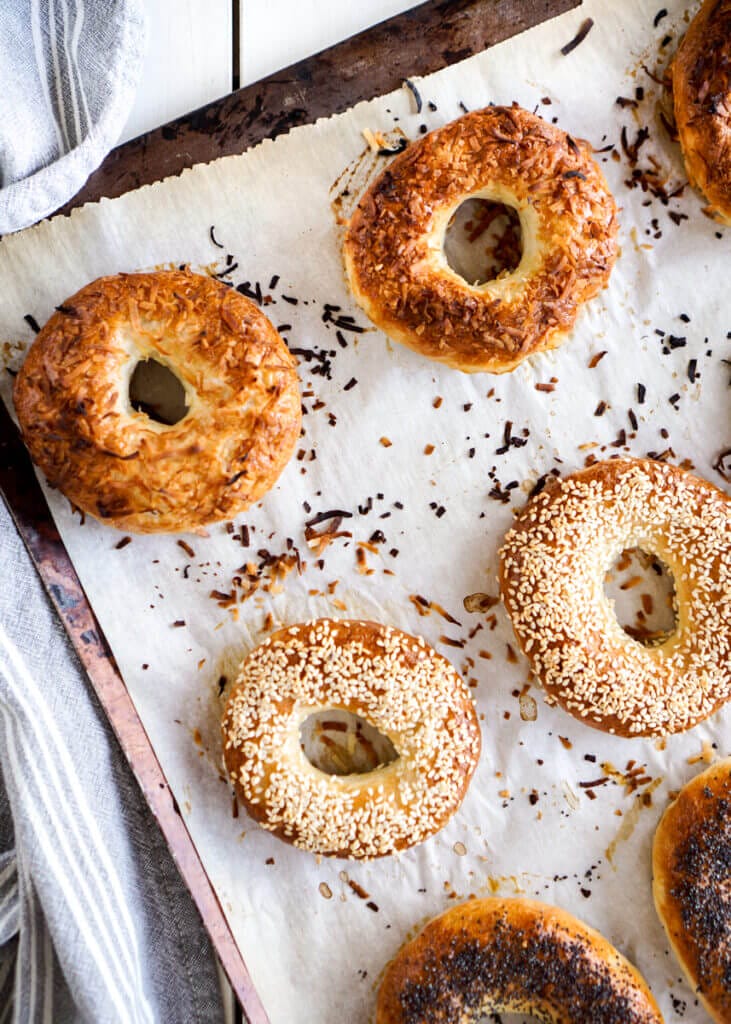
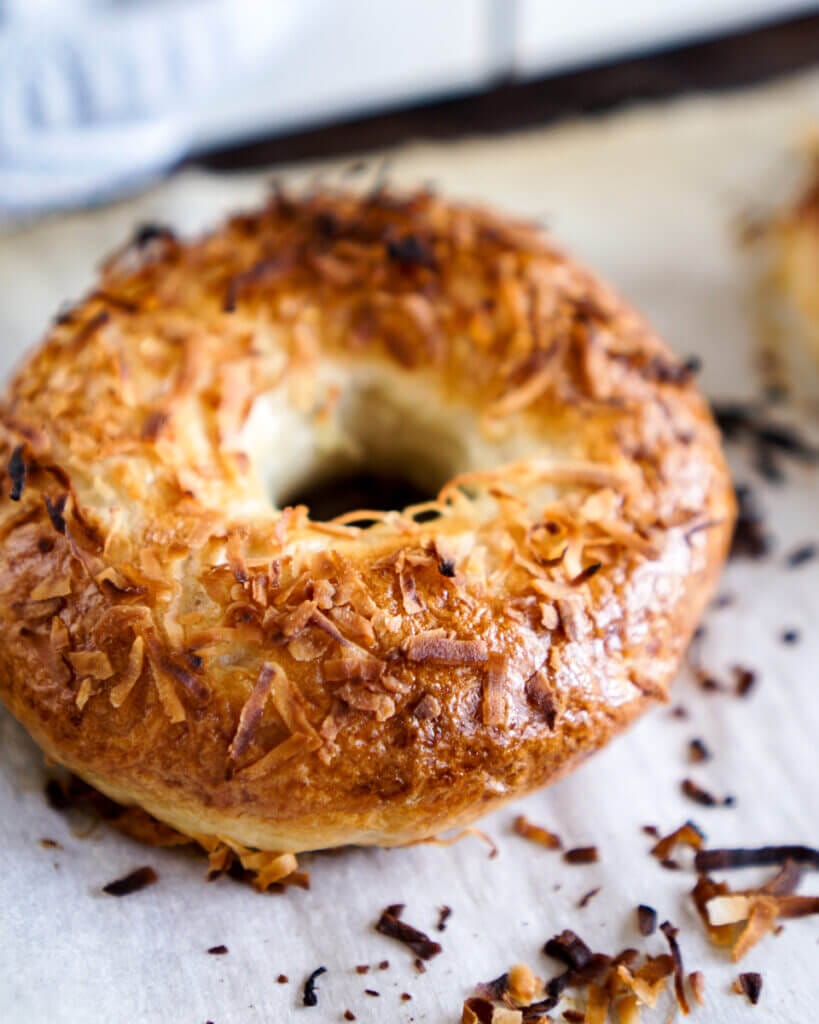
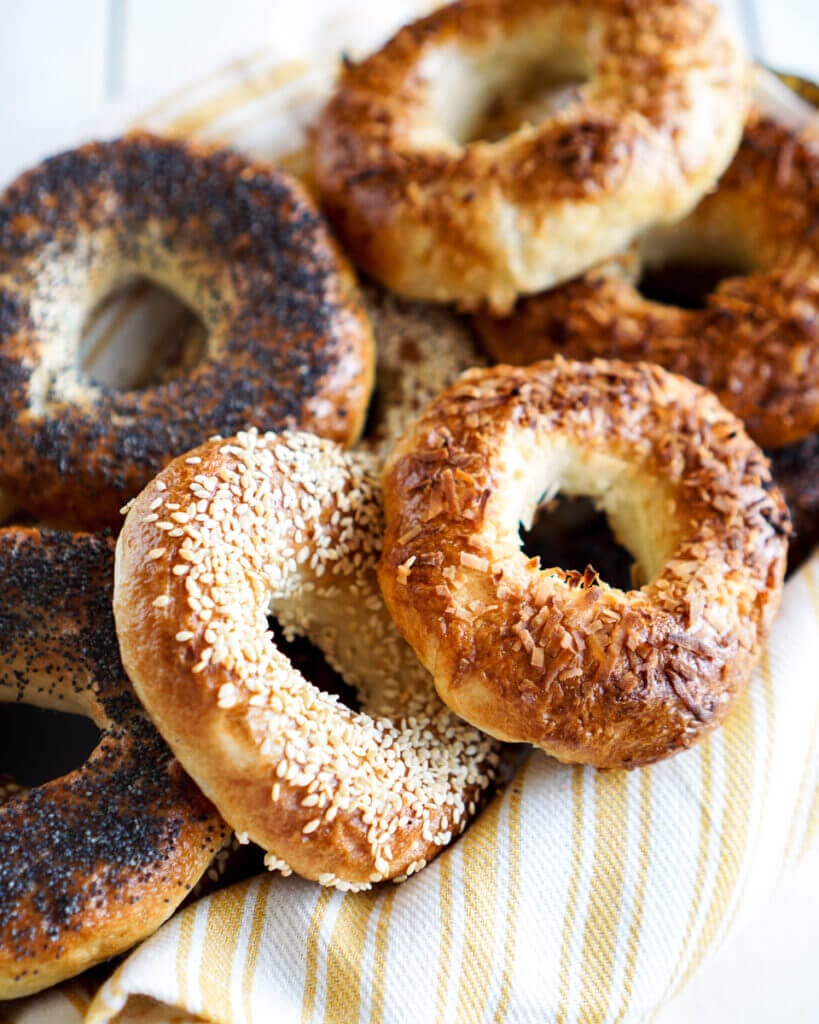
Bagels
Homemade bagels are so fun to make yourself. They are soft, chewy and make the perfect homemade treat for breakfast. Custom make your own variety of flavours by changing the toppings.
- Prep Time: 1 hour 30 mins
- Cook Time: 20 mins
- Total Time: 1 hour 50 mins
- Yield: 12 1x
- Category: Breakfast
- Method: Baking
- Cuisine: German
Ingredients
- 3 – 3 1/2 cups all-purpose flour
- 1 1/2 cups warm water
- 2 1/4 teaspoons (one package) active dry yeast
- 1/4 cup granulated sugar, divided
- 1 teaspoon salt
- egg wash (add 1 tablespoon of milk or water to beaten egg)
- seeds for topping (optional)
Instructions
- In a large mixing bowl, add warm water, yeast and 1 tablespoon of the sugar. Let rest until the mixture starts to foam and creates small bubbles, approx. 8 minutes.
- Add the rest of the sugar, 3 cups of the flour and salt and blend with a wooden spoon. Turn out mixture to a work surface and knead until blended and glutens have developed, about 5-7 minutes (add the rest of the flour as needed).
- Grease a large bowl, place the dough in the middle, cover with plastic wrap and let the dough rest until doubled in size, approx. 1 hour.
- Meanwhile prepare your baking sheets with parchment paper and set aside (you may need two baking sheets).
- Preheat your oven to 450˚F, with the rack placed in the middle of the oven.
- When dough has doubled in size, bring a large pot of water to a boil.
- On a lightly floured surface, press down the dough, and divide the dough into 12 equal pieces, shape dough into round balls, and flatten into discs.
- Take a wooden spoon and use the handle to poke a hole in the centre of the dough. Slip the dough halfway down the wooden handle and then gently spin it around to create a large opening (you can do this with your fingers/hand as well). Repeat with the other pieces, meanwhile keep your dough covered with plastic wrap, or a damp cloth so they don’t dry up.
- Place up to two bagels in the boiling pot of water and boil for 1 minute on each side. Using a slotted spoon remove bagels onto your prepared baking sheet, brush with egg wash and sprinkle desired seeds on top. Continue until all the bagels have been boiled.
- Bake for approximately 20 minutes or until the bottoms are browned and when tapped the bagels sound hollow.
Notes
Seed Options:
– Poppy Seed Bagel
– Sesame Seed Bagel
– Everything Bagel : poppy seeds, sesame seeds, dried minced garlic, dried minced onion, flaked sea salt or coarse salt.
– Onion Bagel: dried minced onion
See blog post for more topping variations; like cheese, coconut, etc.
Bagels freeze well. Freeze half the bagels and take a few out daily to enjoy fresh.
Nutrition
- Serving Size: per bagel
- Calories: 133
- Sugar: 4.3g
- Sodium: 196mg
- Fat: 0.4g
- Saturated Fat: 0.1g
- Unsaturated Fat: 0
- Trans Fat: 0
- Carbohydrates: 28.5g
- Fiber: 1.1g
- Protein: 3.7g
- Cholesterol: 0
FAQ’s
If bagels fall flat or deflate once added to boiling water this could be because of overproofing. If your dough is overproofed it will have no structure to hold itself together and will flop. All the air bubbles and gases pop and leave the dough, resulting in overproofing. Once the dough is submerged into the boiling water the structure collapses.
Homemade bagels are done when the bottoms are browned and when tapped with your finger the bagels will sound hollow.
Yes, you can prep homemade bagel dough just before the boiling stage. The easiest method is to divide the dough into 12 rounds, cover in plastic and then place them in the refrigerator overnight. The next day continue the recipe as is. Flatten the dough, poke holes, boil and bake.
You may also like:
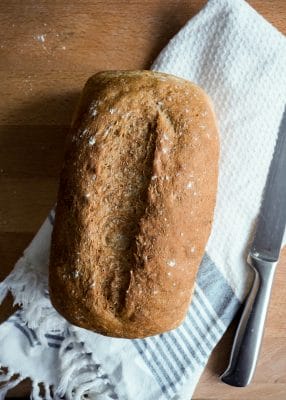




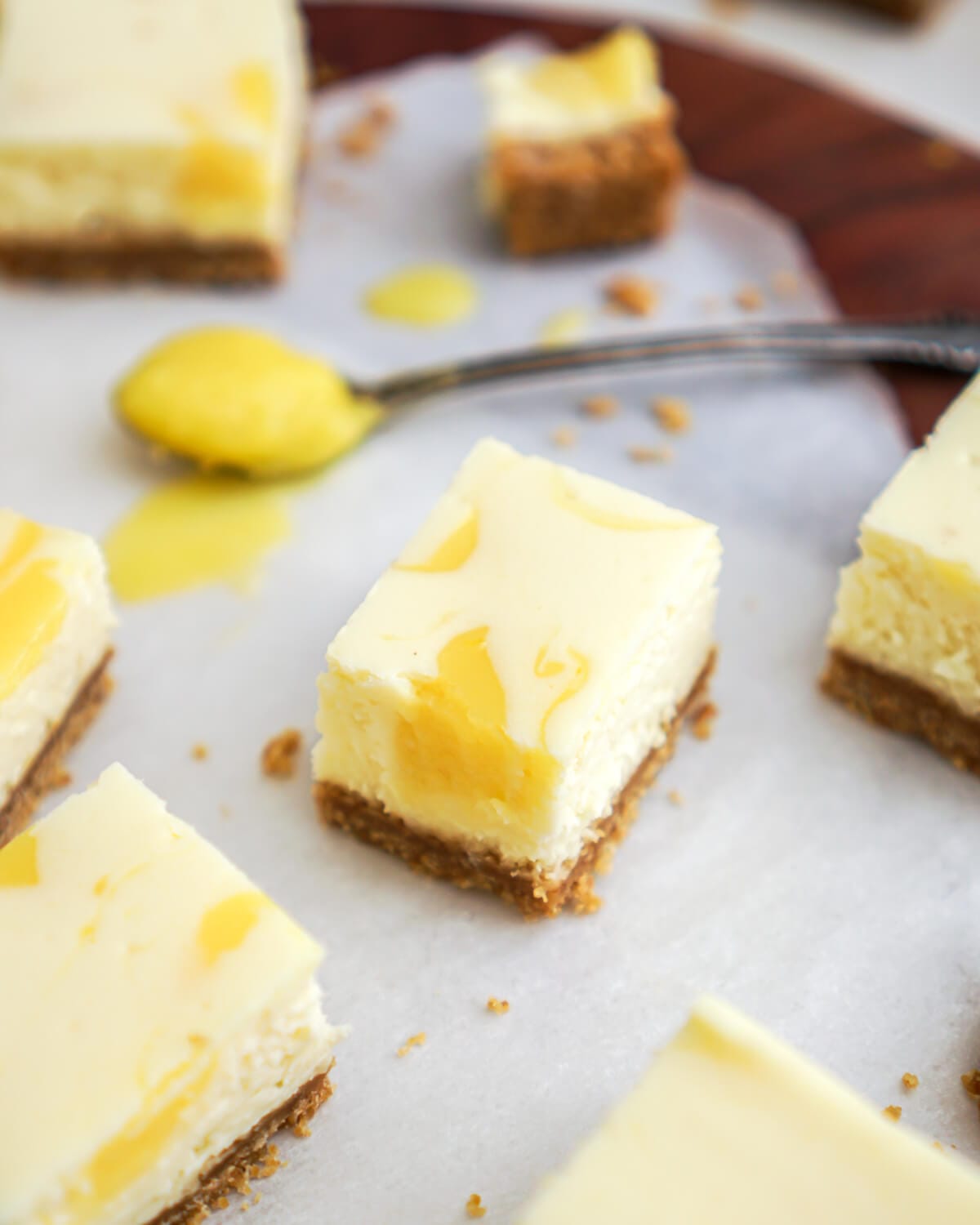
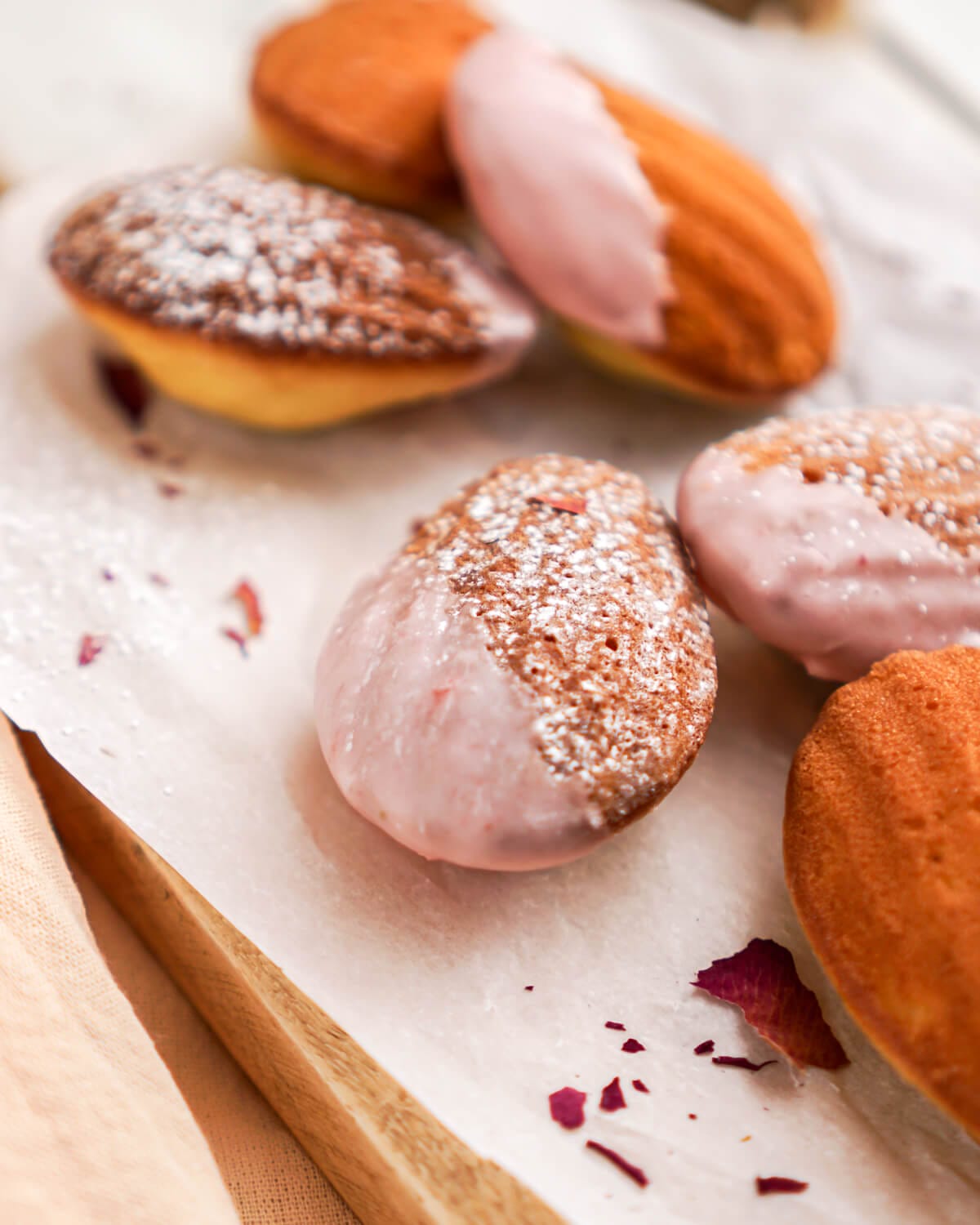

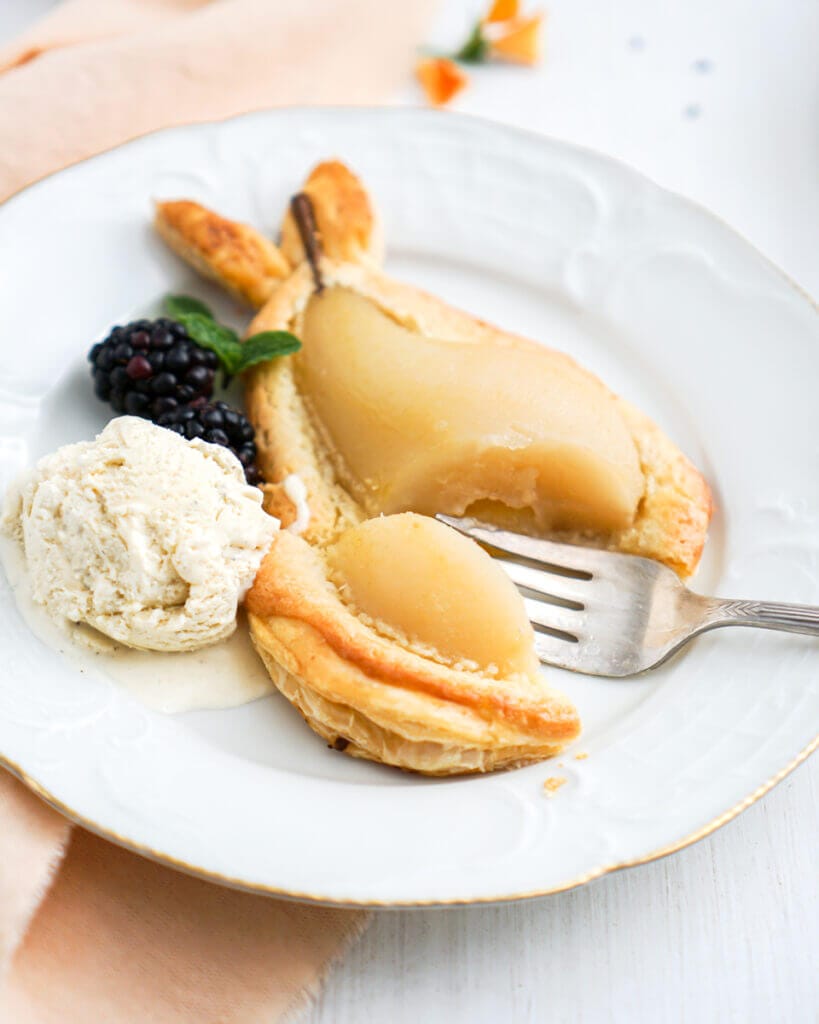


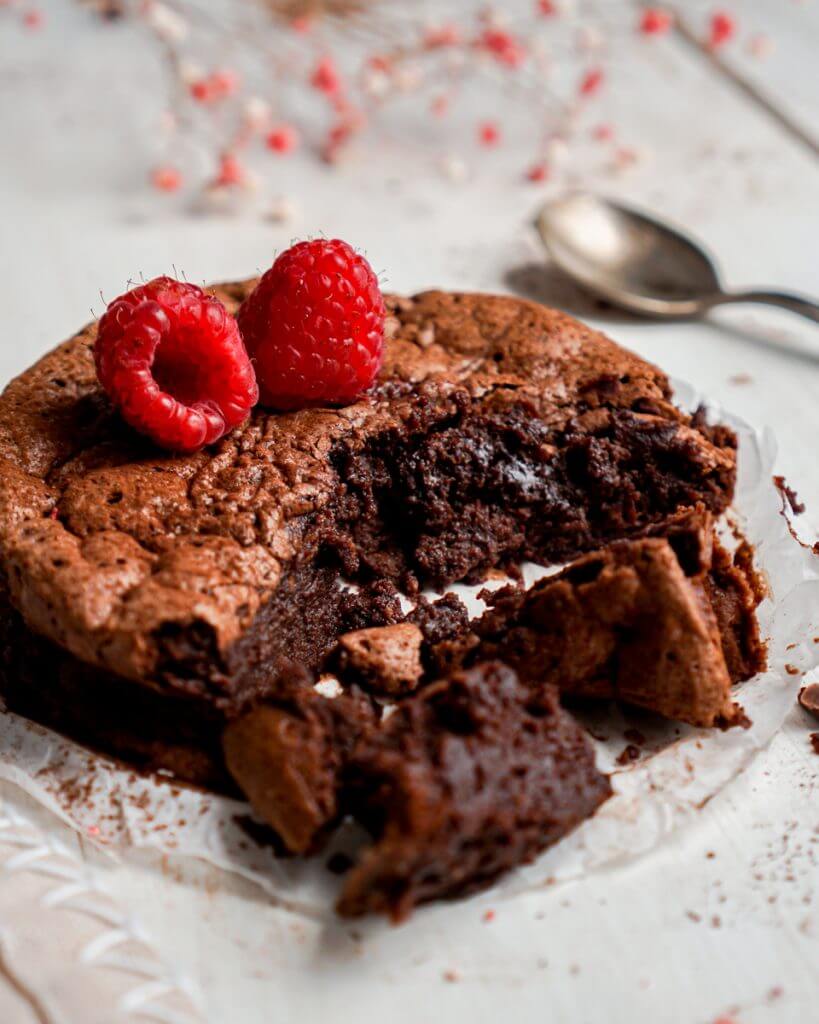






Leave a Rating and Comment!
I love hearing from you! Leave a comment with any questions or how your recipe turned out (your email address will not be published)!
I just made these bagels! So good and such a nice easy recipe to follow. Thanks!
These bagels are so yummy, I probably messed up the dough a bit because I’m still learning and they still turned out sooo yummy! Just curious is it ok to add extra flour if my dough was super sticky?? I’m always worried I’ll add too much. Thanks!
So great to hear Ashley 🙂 I common asked question for sure. It’s normal to get a little sticky – as you knead the dough it should be sticky but not sticking to you. Yes, you can add flour if you feel the dough isn’t workable. The trick is you don’t want to add too much flour, remember as your kneading skills get better over time you’ll handle the dough easier and the dough won’t stick to you as much. Add just a little bit at a time (and as you get better you may not need to add more flour at all). Sometimes the environment or type of flour will affect this too. The more you play about with bread the better you will get at knowing each stage and what it ‘feels’ like.
Also a scrapping tool is a great tool for bread making and will help you handle the bread. Hope that helps.